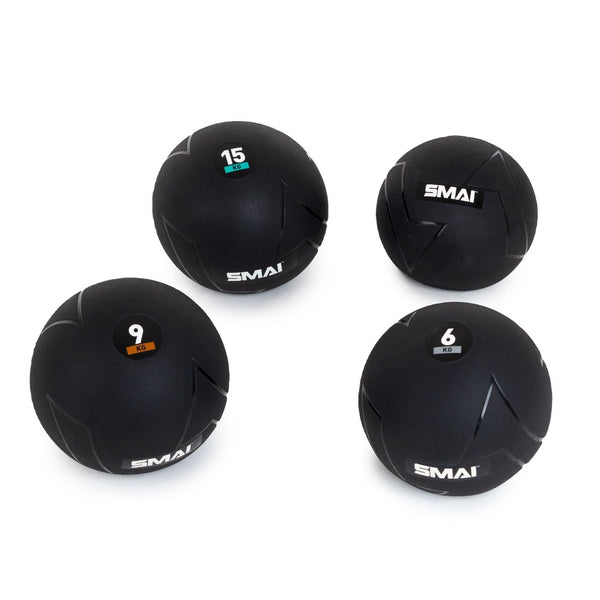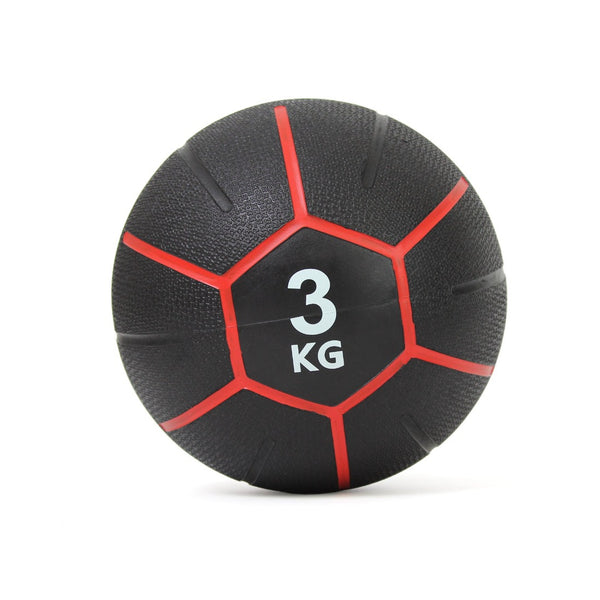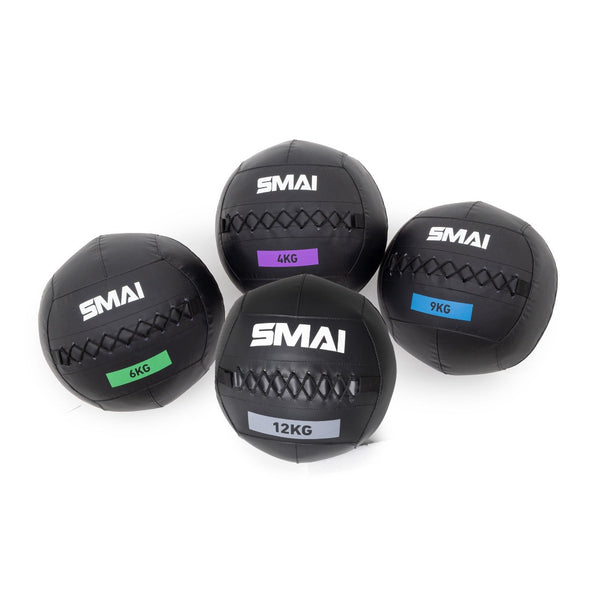Exercise balls are available in a range of types – Slam balls / dead balls, medicine balls and wall balls. Whats the difference?
Exercise balls are available in a range of types – Slam balls / dead balls, medicine balls and wall balls. You’ve seen them at your gym, all lined up on racks in different sizes and materials. But whats the difference? Maybe you are you slamming your medicine ball, when you should be lifting? Or are you lifting your wall ball when you should be throwing? If you are left thinking, "which ball do I use for each exercise?", then stop guessing and get around our guide to exercises balls.
Why does it matter which exercise ball I use?
The answer is in the exercise you'd like to perform. Each type of exercise ball is designed for use under certain conditions. And that makes each type of ball, unsuitable for other types of exercises. When used in the wrong way, an exercise ball can be easily damaged, split or leak. Each ball type has different characteristics that make it better suited to specific exercise types and actions and we should use them to their advantages.
What is the difference between a slam ball / dead ball, wall ball and medicine ball?
The slam ball, or dead ball is a sand filled and weighted ball that is designed to be lifted and slammed to the ground, with little or no bounce effect. The name dead ball refers to the ball falling “dead or flat”. A slam ball should have a durable rubber outer shell with a soft grippy outer surface to allow easy grasp and grip. Workouts using slam balls tend to focus on lifting the ball over head, holding to the chest to perform squats, jumps and slamming the ball to the ground. This requires a no-rebound ball that a slam ball provides.
Medicine Balls are air filled, and have a strong, thick rubber shell that provides the weight to the ball. The look and feel is similar to a basketball, but that’s were the similarities end. The ball is much heavier, and will provide a little bounce. They are smaller then a wall ball, which allows you to get a more powerful grip and throw behind it. A medicine ball is perfect for doing partnered longer distance throws or fast repetition bounce off a wall or bounce and catch off a wall. However a medicine ball is not designed for slams. Performing a slam with a medicine ball can be dangerous due to the bounce, and you will soon split a medicine ball if you perform high power repetitive slams. The outer rubber shell is not designed to absorb the impact of a slam – this is when a slam ball should be used.
Wall Balls are rubber granule and polyester fibre filled to give good bounce and excellent weight balance. The outer is a softer shell that is designed to better absorb impact than a medicine ball. The first thing that surprises many is the size of the wall ball, they are much larger than a medicine ball, and relatively light (between 4kg & 12 kg) . The wall ball is great for developing explosive power, when performing single high speed, powerful throws. The large diameter of a wall ball provides greater air resistance, so while the wall ball may be light, you need to work harder to throw faster and stronger. The wall ball is great for performing side throws, over head throws, crunch throws or improve co-ordination when used with a wall ball throwing target. Like a medicine ball, a wall ball is not designed for use in ground slams. A wall ball can be dangerous to slam due to rebound, and may be prone to split due to the short distance impact of a slam. Always use a slam ball / dead ball for ground slams.
ARE SLAM BALLS A GOOD WORKOUT?
Yes! The nature of exercise balls is that they are made for a variety of exercises. Each exercise ball type can be considered versatile, with many universal workouts that can be performed with all exercise ball types. A report by the University of Arkansas shows that exercise ball training is not only effective for core strength, but many ball exercises involve full body movements. Full body movements allow you to combine cardio and strength training in the same workout.
WHAT EXERCISES CAN I DO WITH A BALL?
Many simple exercises can be performed with either a slam ball or medicine ball. Due to the larger size of a wall ball, some universal exercises will be less practical. A complete ball exercise program includes four focus areas - Balance, endurance, strength training and flexibility / stretching
Balance exercises
Side Bends
1. Stand with your feet a little wider than shoulder-width apart.
2. Hold the medicine ball at your waist.
3. Bend slightly at the waist and slowly lean to one side
and then to the other.
4. In the direction you are leaning, bend that knee and
move the medicine ball toward the hip on the same side.
HIP CIRCLE
1. Stand with your feet shoulder-width apart and knees slightly bent.
2. Hold the medicine ball in one hand and pass it around your body, switching hands behind your back.
ABOVE HEAD LATERAL FLEX
1. Stand with your feet shoulder-width apart and knees slightly bent.
2. Hold the medicine ball over your head and slowly lean to one side by bending at the waist.
3. Return to centre position
A complete ball exercise program includes four focus areas - Balance, endurance, strength training and flexibility / stretching
Jessica Vincent, University of Arkansas
Endurance exercises
JUMP AND PICK UP
1. Start with your feet flat on the ground and the ball held firmly between your ankles. Your knees should be bent slightly so that you are in a shallow squatting position
2. From this position, perform an explosive jump upward and lift the ball in front of you by pulling both knees up quickly toward your chest to near-chest level.
3. Catch the ball with both hands in front of your chest as your feet land on the ground. Repeat.
V UP
1. Lie faceup, legs extended. Holding a ball with both hands, reach your arms overhead
2. Engage your core to lift your hands and feet simultaneously so your body forms a V position. At the top of the V, keep your core engaged and slowly lower your feet to the floor and arms back to the floor above your head. Repeat.
SIDE LUNGE
1. Stand with your ball held at chest height, pulled close to your chest.
2. Keep your left foot in position, while taking a side step with your right foot into a low side lunge. Slightly bend your right knee as you step to the right, to drop your hips towards the floor.
3. Return to centre position, then reverse your side lunge to the left. Repeat from step 1.
STRENGTH EXERCISES
SQUAT AND SWING
1. Start standing, holding a ball at your waist.
2. Move down into a squat lowering the ball between you knees.
3. Stand back up into upright position, and swing the ball above your head with straight arms.
4. Bring your arms back to centre waist. Repeat.
Knee LIFT & TAP
1. Hold a ball above your head with straight arms
2. Balancing on your left foot, lift your right knee up to waist height, and lower the ball down to tap your knee.
3. Drop your knee and foot to the floor, and raise the ball above your head again
4. Lift your left knee up to waist height, and lower the ball down to tap your knee.
3. Drop your knee and foot to the floor, and raise the ball above your head again. Repeat.
Overhead LUNGE
1. Stand with your ball held above your head with straight arms
2. Engage your core and step forward with your right foot and bend your knees down into a lunge position.
3. Push through your right foot to stand up, bringing your trailing left foot forward to meet your right foot.
4. Repeat, this time on your left leg out first. Move forward with each step / lunge rather than standing in place with each step.
FLEXIBILITY / STRETCH exercises
WARRIOR POSE
1. Stand with a wide stance, feet wider than your shoulders. Hold a light ball above your head with straight arms
2. Turn your right foot out 90 degrees and bend the knee.
3. Keeping your back and arms straight, bend to the side at the waist to lower to the side laterally, until it is over your knee.
3. Stand back up into upright position, then repeat over the opposite knee.
TOE TAP
1. Stand with a wide stance, feet wider than your shoulders. Hold a light ball at middle waist
2. With straight arms, bend at the waist and have your hands follow your leg down and tap your foot with the ball if you can reach. Follow the same path back to an upright position. Repeat on opposite leg / foot.
Phew! You made it to the end! If you are looking for more, there's even more product information and ideas in our fitness collection, or contact sales@smai.com.au for more information.


